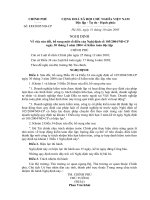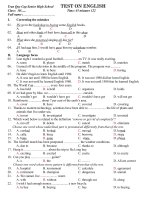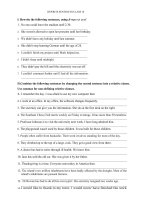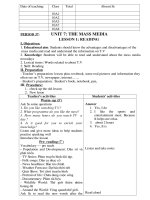Class 10 2
Bạn đang xem bản rút gọn của tài liệu. Xem và tải ngay bản đầy đủ của tài liệu tại đây (2.93 MB, 44 trang )
Japan’s Experience in Water Resources Development
A Case Study on the Aichi Canal Project financed by the World Bank
by Yoshida, Professor, the University of Tokyo
1
Source: JWA, 水機構
An Atomic Bomb in Hiroshima
2
Hiroshima city after the bomb explosion
3
Tokyo after the war in 1945
4
Osaka after the war in 1945
5
Losses by the Second World War
Japan lost one-fourth of total national wealth during the Pacific War
Death toll in Japan
Soldiers killed
Civilians killed
Sino-Japan (1937-41) 511,000
Pacific war(1941-45)
1,555,000
299,000
World Physical Loss of The Second World War
Military expenditure US$1,117 billion
Total damages US$4,000 billion
Soldiers death toll 15 million, Civilians 45 million
Civilians killed in Asia during the war were not well known.
6
Lesser Damages on Infrastructure
→ One of Secret Factors for the Rapid Recovery
War Damage Ratios of Infrastructure
Ratio = (War Damage)/(Assumed Value without War Damage)
%
ag
er
Av
We
ig
ht
ed
te
Wa
e
ad
rS
up
Ro
y
pl
ns
io
at
ic
Co
mm
un
Fa
s
Ga
ci
Fa
c
t ri
ec
El
ci
l it
li t
ie
s
ie s
s
ay
ilw
Ra
Br
id g
es
ls
na
Ca
Po
rt
s
40
35
30
25
20
15
10
5
0
7
War Damages on Industrial Productive Capacities
→ The heavy damages lead to quick modernization of industrial capacities
Loss of Industrial Productive Capacity by War
C ap ac ity L oss R atio (% )
70
60
Ratio = (Capacity Loss)/(Assumed Capacity without Loss)
50
40
30
20
10
0
Power
Iron and
Steel
NonFerrous
Machine
Chemical
Fiber
Oil
Refinary
Industry
8
Reconstruction from the Ruins
9
Post-War Development and WB’s Assistance
What learnt from the Assistance
Development Phase in Postwar Japan
400
350
In de x (1 9 5 5 = 1 0 0 )
300
Loans from WB (1953-66)
31 Projects with $862 million
実質賃金(Real Wage Rate)
停滞期 Stagnated
Period
(1953-1966)
250
安定成長期 Stabilized
Growth Period
高度経済成長期 Accelerated
Growth Period
GDP
GDFCF
200
150
製造業 (MFSector)
労働人口(LF)
GDP=Gross Domestic Product「国内総生産)
GDFCF=Gross Domestic Fixed Capital Formation(総国内固定資本形成)
100
耐久消費財輸入局面
Import Substitution
of Durable Goods
50
規模と資本集約財輸出局面
Export of Scale Intensive
and Capital Goods
耐久消費財輸出局
面 Export of
Durable Goods
技術集約財輸出局面
Export of Technology
Intensive Goods
0
1955
1960
1965
1970
1975
Year
1980
1985
1990
1995
2000
10
World Bank Loans to Japan (1953-1966)
日本の世界銀行からの借款実績(1953-1966)
契約
調印日
件数 (年月日) 借入人
1 531015 日本開発銀行
2 531015 日本開発銀行
3 531015 日本開発銀行
4 551025 日本開発銀行
5 560221 日本開発銀行
6 561219 日本開発銀行
7 561219 農地開発機械公団
8 570809 愛知用水公団
9 580129 日本開発銀行
10 580613 日本開発銀行
11 580627 日本開発銀行
12 580711 日本開発銀行
13 580818 日本開発銀行
14 580920 日本開発銀行
15 580920 日本開発銀行
16 590217 日本開発銀行
17 591112 日本開発銀行
18 591112 日本開発銀行
19 600317 日本道路公団
20 601220 日本開発銀行
21 601220 日本開発銀行
22 610316 日本開発銀行
23 610502 日本国有鉄道
24 611129 日本道路公団
25 630927 日本道路公団
26 640422 日本道路公団
27 641223 首都高速道路公団
28 650113 電源開発(株)
29 650526 日本道路公団
30 650910 阪神高速道路公団
31 660729 日本道路公団
受益企業
対象プロジェクト計画
関西電力
多奈川火力2基(75千KW)
九州電力
刈田火力1基(75千KW)
中部電力
四日市火力1基(66千KW)
八幡製鉄→日本製鉄
圧延設備
基幹産業4社(注1)
鋼管・輸送車輌・船タービン・ディーゼル製造設備
川崎製鉄
千葉工場?ット及びゴールドストリップ・ミル
農地開発機械公団
開墾事業/泥炭/乳牛輸入分/保留分(注2)
愛知用水公団
愛知用水事業
川崎製鉄2次
千葉工場千トン高炉およびコークス炉
関西電力2次
黒部第4水力発電(185千KW)
北陸電力
有峰水力発電(264千KW)
住友金属
和歌山工場千トン高炉精銅??設備
神戸製鋼
瀬浜工場800トン高炉
中部電力2次
畑薙第一、第二水力発電
日本鋼管2次
水江工場60トン転炉
電源開発
御母衣水力発電(215千KW)
富士製鉄
広畑工場1500トン高炉1基
八幡製鉄2次
戸畑工場1500トン高炉第二基
日本道路公団
尼崎-呉東間高速道路
川崎製鉄3次
千葉工場厚板工場新設
住友金属2次
和歌山工場コンバインドミル
九州電力2次
新小倉火力(156千KW)
日本国有鉄道
東海道新幹線
日本道路公団2次
一宮‐栗東 尼ガ崎-西宮間高速道路
日本道路公団3次
東京-静岡間高速道路
日本道路公団4次
豊川-小牧間高速道路
首都高速道路公団
羽田-横浜間高速道路
電源開発(株)
九頭竜川水系長野および湯上発電所建設
日本道路公団5次
静岡-豊田間高速道路
阪神高速道路公団
神戸市高速道路1号
日本道路公団6次
東京-静岡間高速道路
償還 据置
利率
借款額
期限 期限
(%)
(千米$) (年) (年)
5.000
21,500
20
3.5
5.000
11,200
20
3.5
5.000
7,500
20
3.5
4.625
5,300
15
2.5
4.750
8,100
15
2.5
5.000
20,000
15
3.5
5.000
4,300
15
3
5.750
7,000
20
4.5
5.625
8,000
14
2.5
5.625
37,000
25
4.5
5.625
25,000
25
3.5
5.625
33,000
15
3
5.625
10,000
15
3
5.500
29,000
25
4
5.500
22,000
15
2
5.250
10,000
25
5
6.000
24,000
15
2
6.000
20,000
15
2
6.250
40,000
23
3
5.250
6,000
15
3
5.250
7,000
15
3
5.250
12,000
20
1.5
5.250
80,000
20
3.5
5.250
40,000
23
3
5.500
75,000
26
5.5
5.500
50,000
25
5
5.500
25,000
24
4
5.500
25,000
25
4
6.500
75,000
25
4.5
6.500
25,000
24
4
6.750 100,000
15
3
合計 862,900
(注1)
日本鋼管→継目なし中継管製造設備、トヨタ自動車→挙母工場トラック・バス用工作機械、石川島重工→東京工場船舶用ター
三菱造船→長崎造船所ディーゼルエンジン製造設備
(注2)上北?川地区開墾事業/薩津泥炭/乳牛輸入分/保留分
11
WB Loans by Sector
Loans from World Bank by Sector
180
L o a n A m o u n t ( $ m illio n )
160
Agriculture
Industry
Electricity
Transportation
140
120
100
80
60
40
20
0
1953 1954 1955 1956 1957 1958 1959 1960 1961 1962 1963 1964 1965 1966
12
Year
Major WB Financed Projects
Sinkansen
Hydropower
Steel Plant
Highways
Shipbuilding Industry
Truck Industry
13
General Lessons Learned from the WB’s Assistance
Lessons at Project Level
•
•
•
•
•
•
•
Introduction of new methods in planning, designing and construction, but,
procurement practices were not well transferred.
Justification from macro, sector, regional policies.
Introduction of sound project investment analysis.
Emphasis on financial viability of service providers and pricing.
Promotion of technology transfer and innovations.
Human resources development.
Institutional building.
Lessons at Policy Level
• Consistency between macro-economic management and project investments.
• Institutional reforms including new laws, organizations, and regulations.
14
A Case Study: A Review of the Aichi Canal Project
The Kiso River System and the Aichi Canal Project
Total canal length 112 km
Open canal 63 km
Tunnel 28 km
Siphon 12 km
Others (bridges, etc) 6 km
Maximum capacity 30 m3/s
Branch canals 1,012 km
Project Components
Irrigated Area 33,000 ha
Farms 45,000(1957)→ 20,000(2000)
Water supply 195,000
Industrial water supply 37 million m3
Electricity 35,000 kw
15
Project Area and People
Rain-fed Agriculture by Irrigation ponds (before the project)
These ponds were converted into paddy fields.
16
Problems: drought prone areas
Data and statistics were accumulated.
(Statistics paranoid?)
Japanese are paranoid in statistics.
17
Priority Needs of Local People and Their Initiatives
Hand swing bucket irrigation (before project)
Shortage in Domestic Water Supply
The people in this town located in the southern tip of the peninsula had prepared by
18
themselves a town water supply fund and system before the water reached the town.
How was the priority needs being identified by the farmers?
Demonstration Effect (1891~ )
• Local farmers’ knowledge about the impact of irrigated agriculture
demonstrated by the neighboring Meiji canal project (since 1891).
→ We want the same because we know how large benefit we can get.
Who are the project promoters? (1948~1957)
• Farmers’ leader Mr. Kuno who was so talented in local communications and
active in local business.
• The local agriculture high school teacher, Mr. Hamajima who was capable of
planning an irrigation project.
• A local city mayor who once worked as a correspondent in USA before the
war played an important role of “communicator” to external resources. He
knew “democracy” practiced in USA, and various public projects including
TVA project in USA.
• The local leaders had good connections with the local and central authority.
19
Project Promoters: Local Farmer and Teacher
Mr. KUNO and Mr. Tatsuo Hamajima (1970)
20
How were the local people participated in the project ?
In 1948, the promoters visited and persuaded the villagers.
– Consultation meetings in all villages.
– Project presentation through local entertainers (local folk tellers).
– Later, the project concept brief was circulated to all the elementary
school pupils in which TVA and Dutch farming system were cited as the
models for the proposed Aichi Canal project.
In 1948, Kuno and Hamajima petitioned to the central government and met
with the then prime minister Yoshida.
In 1949, The Aichi Irrigation Water System Realization League was organized.
In 1949, The project proposal was prepared in English by Mr. Mori (city
mayor) to be presented to GHQ. Japan was ruled by the Allied Occupation
Army until 1952 when the San Francisco peace treaty was enacted.
21
Project Proposal prepared by
the Project Realization League in 1949 – Cover Page
Prepared by the farmers group of “Project Realization League” in 1949 22
Farmers Proposal and Government’s Objectives
How was the Project kept consistent?
1948 The Project was conceptualized by the local leaders. (Kuno and
Hamajima)
–
–
The promoter visited and discussed with then prime minister Yoshida who
was in support of the project concept.
The Ministry of Agriculture staff visited the project area.
1950 TVA concept was introduced among the stakeholders. Then the scope
was scaled up including electricity, industrial water and urban water.
1951 The Kiso river comprehensive water use survey office was established
by the Ministry of Agriculture.
Local needs
→ Drought prone area → prevailing poverty and shortage of water.
→ But, the climate, soil and location are good for farming.
The local priority needs met with:
National and agriculture sector needs
→ Food security: Rice production increase was the first priority.
→ Social Stability: Employment creation.
23
Coordination among Government Agencies → A New Concept
Multipurpose development:
Irrigation → Ministry of Agriculture
Domestic water supply → Ministry of Welfare
Industrial water supply → Ministry of T/I
Hydropower (Electricity) → Ministry of T/I
Flood control → Ministry of Construction
TVA Approach
→ USA’s Tennessee Valley Authority’s experience in 1930 (New Deal Policies)
→ Comprehensive development of the Kiso river basin
Institutional Evolution → Concept of IWRM (WWF3 2004)
• 1955 → Aichi Canal Public Corporation (1955) for the project implementation
• 1968 → Later merged with the Water Resources Development Corporation which
was responsible for developing 7 major river basins in Japan.
• 2004 by the administrative reform act, transformed into Japan Water Agency.
24
However, Affected People’s Oppositions Movement (1952~1958)
Pro vs. Con Against the Project – Democracy was Working?
25
Signboard saying “Oppositions to Dam Construction”









